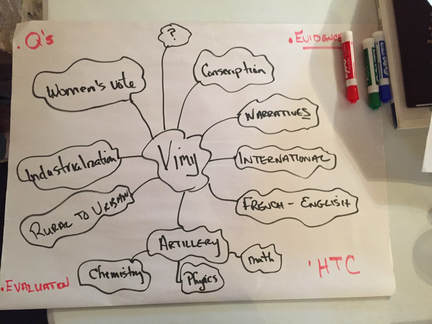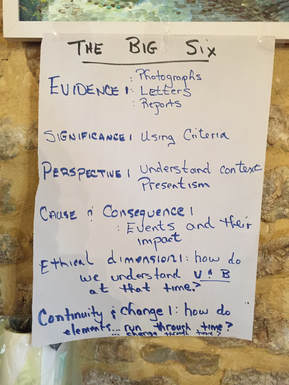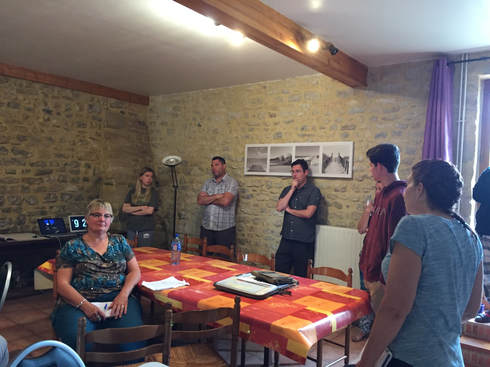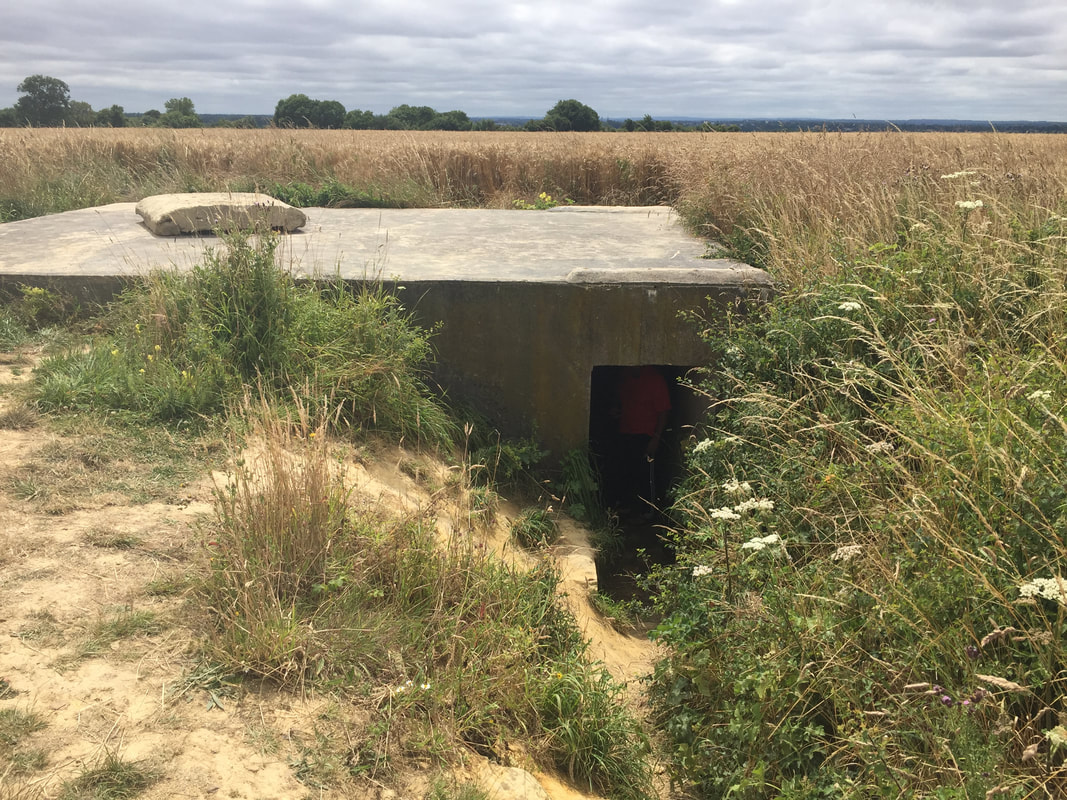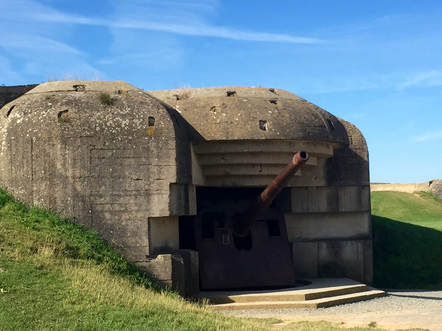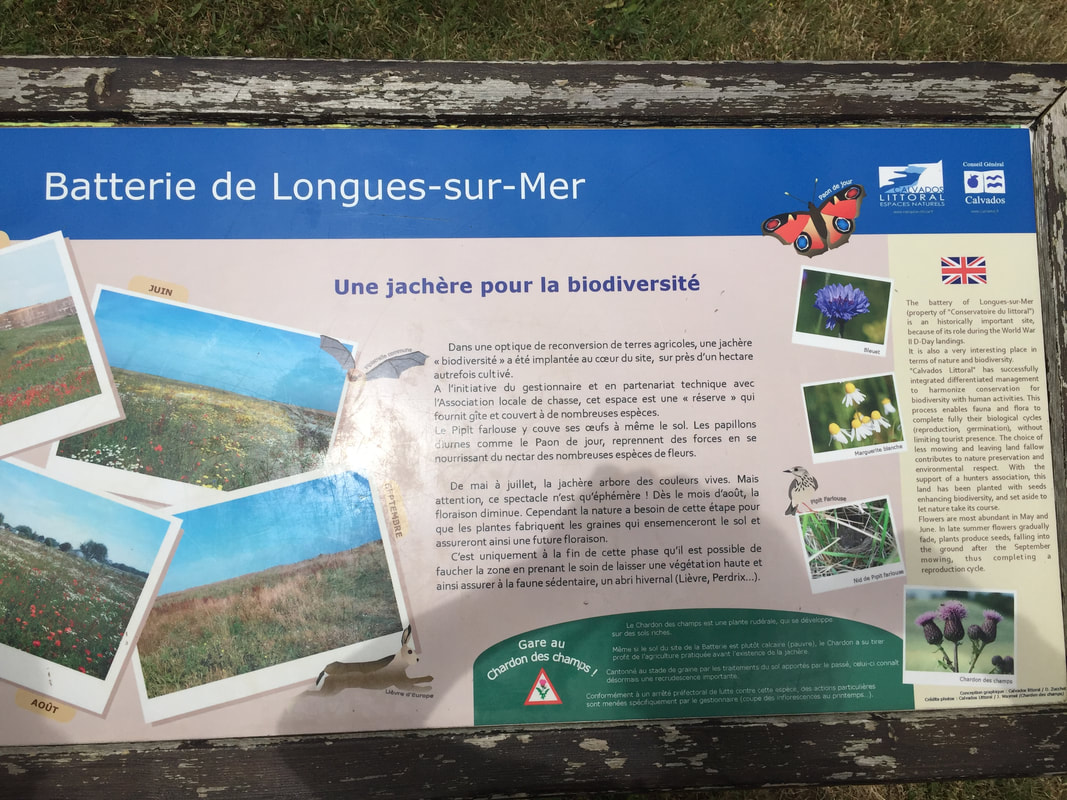"Education is more complex than brain surgery."
Today's Itinerary and Activities
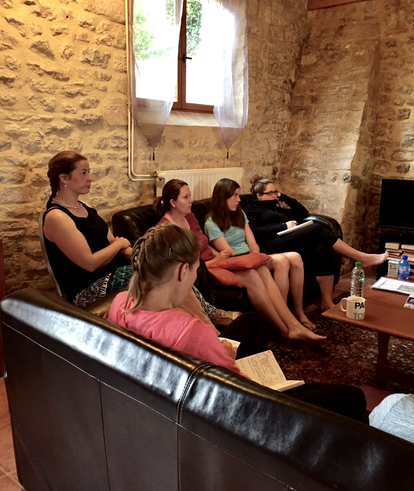 (Clockwise from front) Ronda, Lynzee, Lori, Janelle, and Jessica
(Clockwise from front) Ronda, Lynzee, Lori, Janelle, and Jessica
The Moulin Morin is a reconstructed mill located west of Bayeux. It consists of three buildings, each of which has multiple apartments. The Kingfisher, one of the buildings, has a large main floor, which we will be using as a classroom throughout the week.
We spent our first morning at the Moulin Morin in the classroom participating in a workshop led by Blake. Blake provided us with invaluable insights into how to implement inquiry-based learning. Specifically, he demonstrated how to teach Canada's experiences during the First World War through Big Ideas and the Big Six historical thinking concepts. At the end of the workshop, Cindy, Blake, and Lee explained that we will be spending the next week piecing together the Normandy Campaign by participating in discovery- and inquiry-based learning activities.
Following the workshop, we had lunch and then drove to the Batterie Allemande, which is more commonly known among Anglophones as the German Battery at Longues-sur-Mer. Upon arriving at Longues-sur-Mer, we interrogated the site. After an hour of exploration, we came together to share our discoveries.
We then returned to the Moulin Morin where we enjoyed a relaxing evening in our respective apartments.
We spent our first morning at the Moulin Morin in the classroom participating in a workshop led by Blake. Blake provided us with invaluable insights into how to implement inquiry-based learning. Specifically, he demonstrated how to teach Canada's experiences during the First World War through Big Ideas and the Big Six historical thinking concepts. At the end of the workshop, Cindy, Blake, and Lee explained that we will be spending the next week piecing together the Normandy Campaign by participating in discovery- and inquiry-based learning activities.
Following the workshop, we had lunch and then drove to the Batterie Allemande, which is more commonly known among Anglophones as the German Battery at Longues-sur-Mer. Upon arriving at Longues-sur-Mer, we interrogated the site. After an hour of exploration, we came together to share our discoveries.
We then returned to the Moulin Morin where we enjoyed a relaxing evening in our respective apartments.
Technology
"What has education done to accommodate Google?"
During our workshop, we discussed the importance of educators and educational leaders having a growth mindset (as opposed to a fixed mindset) and embracing technological innovations such as cellphones and tablets. These innovations enable teachers to more easily address multiple intelligences and engage students in meaningful, real-world learning experiences. Technology also allows students to present their learning in ways that can reach a wider audience.
Historical Thinking in the Classroom
"Education must be active, not passive."
|
Blake demonstrated that we can always attach a few Big Ideas and at least one historical thinking concept to the content that we teach. The following is an example of how students can study a historical event and develop historical thinking skills through examining Big Ideas.
Topic: The Battle of Vimy Ridge Looking at the image to the left, a thorough study of the Battle of Vimy Ridge involves examining and understanding (among other Big Ideas) multiple narratives of the battle, Conscription, International Law, French/English relations, artillery, changes in rural and urban communities, industrialization, and women's voting rights. Furthermore, each of these topics can cross over into other curricular areas. For instance, a thorough study of the artillery employed during the Battle of Vimy Ridge can also cover outcomes outlined in Mathematics, Chemistry, and Physics curricula. During their study of the Big Ideas related to the Battle of Vimy Ridge, students learn how to effectively use primary evidence, how to critique the battle's causes and consequences, and how to analyze and develop historical perspectives. Students also have the opportunity to question the ethical dimensions of the dominant narratives surrounding the battle, debate the historical significance of the battle, and identify how the battle continues to impact populations in the twenty-first century (continuity and change). Although this teaching method might appear overwhelming, it empowers students to develop critical thinking skills, Powerful Questions, and project ideas. |
Know By Doing: Engaging Project Ideas
"Students feel empowered when they create public learning resources
because they are contributing to a narrative and a legacy."
because they are contributing to a narrative and a legacy."
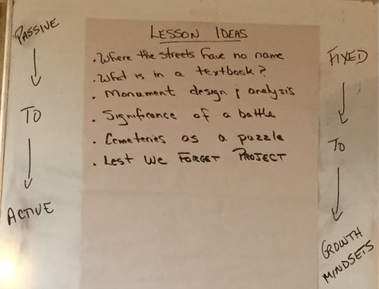 Throughout the workshop, Blake used a whiteboard, chart paper, and markers to outline his main ideas
Throughout the workshop, Blake used a whiteboard, chart paper, and markers to outline his main ideas
During our workshop, Blake shared some great project ideas. He also emphasized the benefits of building authentic partnerships with local, national, and even international organizations.
The following are projects that Blake has successfully implemented in his classroom:
The following are projects that Blake has successfully implemented in his classroom:
- Lest We Forget: Students conduct research and write a biographical sketch of a soldier.
- Where the Streets Have No Name: Students research the lives of men and women listed on their local cenotaphs. They then decide which unnamed streets in their town/city should be named after the individuals they researched. Students can also partner with the municipal government to petition for the naming of the streets.
- Monument Analysis and Design: Students either analyze a monument or design a monument and explain the significance of its different elements. This project allows students to build authentic partnerships with organizations: They can share their monument designs with organizations working towards erecting monuments.
- Significance of a Battle: Students use primary evidence to argue the importance or insignificance of a battle.
- What is in a Textbook?: Students go through (sections of) a textbook with a critical eye to determine what events are included and what perspectives the textbook authors have taken. Students can then use evidence to present their own historical perspectives of an event. Students can also compare and contrast the events included in textbooks written during different time periods.
The Widespread Impact of Students' Work
"Let's empower students to apply their knowledge and skills
to make a difference in the real world through their learning."
to make a difference in the real world through their learning."
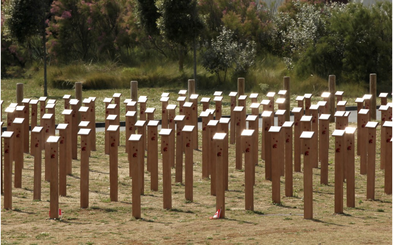 Part of the museum exhibit developed by Smith Falls, Orillia, and Oakville students (http://www.junobeach.org)
Part of the museum exhibit developed by Smith Falls, Orillia, and Oakville students (http://www.junobeach.org)
In addition to the projects listed above, Blake shared an additional project that Smith Falls high school students recently completed:
- Canada's D-Day Tribute Campaign: Canadian History and Computer Programming students at Smiths Falls Collegiate joined with students from Orillia and Oakville to research the 359 Canadian soldiers killed on D-Day (6 June 1944). They created biographies for each of these fallen soldiers, as well as a database that can be accessed through a Windows app. The goal was to let students become the custodians of the memory of the soldiers killed on D-Day. In partnership with the Juno Beach Centre in Normandy, an exhibit showcasing the students' work was installed at the Centre in 2014 for the 70th anniversary commemorations of the D-Day Invasions.
Assessment
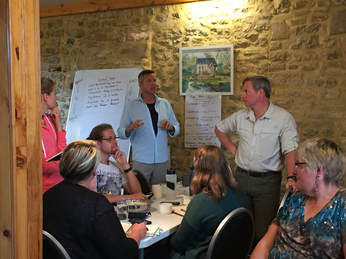 (Clockwise from front left) Kathryn, Karen, Zakk, Blake, Joel, Lorelei, and Abbi
(Clockwise from front left) Kathryn, Karen, Zakk, Blake, Joel, Lorelei, and Abbi
Blake explained that one of the key skills for teachers to evaluate is their students' ability to effectively communicate their learning. This includes assessing how well students adapt the presentation of their learning to the space and their audience.
Blake also detailed the importance of student voice. He explained that teachers often assign projects with preset rubrics to evaluate students' learning. To ensure that all students have the opportunity to develop knowledge and skills that are new and relevant to them, Blake suggested that teachers co-construct projects and assessments with individual students.
Blake shared an added bonus of co-construction: student ownership of projects and assessments leads to heightened engagement.
Blake also detailed the importance of student voice. He explained that teachers often assign projects with preset rubrics to evaluate students' learning. To ensure that all students have the opportunity to develop knowledge and skills that are new and relevant to them, Blake suggested that teachers co-construct projects and assessments with individual students.
Blake shared an added bonus of co-construction: student ownership of projects and assessments leads to heightened engagement.
Reflections on This Morning's Workshop
The participants below shared their big takeaways from Blake's workshop:
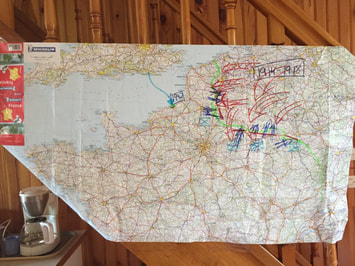 This map is one of the many resources we will reference throughout the week.
This map is one of the many resources we will reference throughout the week.
- Abbi: "The importance of student voice in the classroom was my big takeaway. Blake outlined various strategies that allow students to be in charge of their own learning, which I hope to implement in my own classroom some day. Blake explained how the historical thinking concepts allow for students to have a greater say in their inquiry and analysis, and promote engagement."
- Andrew: "My big takeaways from Blake's workshop were different methods of communicating learning. Like using softwares other than Microsoft."
- Emily: "My big takeaway from Mr. Seward's workshop was how history is not about the names and dates but about the skills you develop by doing critical thinking and analysing work. I understand how skill development will prepare me for university. I now also know that my teachers do care about how they teach us and that they work so hard on these professional development tours to develop their own skills to help their students learn."
|
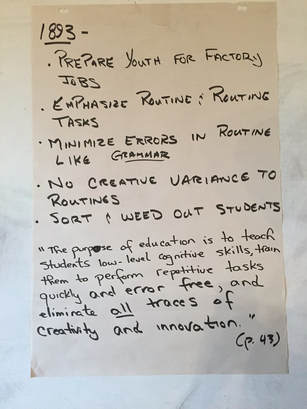 Some aspects of current pedagogical practices date back to the nineteenth century
Some aspects of current pedagogical practices date back to the nineteenth century
- Marshall: "I came away with many project ideas! I can either use them or offer them to teachers."
- Mike: "I learned solid ways to embed the Historical Thinking Concepts into instruction naturally."
- Robert: "I found the discussion about the Historical Thinking Concepts very important. It was a way for me to express myself and my understanding of the concepts. I was able to sort out their meaning, the way of using them in the classroom, and how I can apply them to my classroom. It was a morning during which many AHA! moments occurred."
- Ronda: "Formal education for the masses began with the Industrial Revolution - it's not a surprise that education was designed to equip people to participate in factories, etc. The changes that have taken place in society require a change in focus for education."
- Simon: "I discovered that today's teaching practices date back to the 1840s. I also learned that the purpose of structure/control in the classroom is to provide teachers with comfort, not to enhance learning. As well, I came to understand the need for flexibility in the classroom. I now understand that student-centred teaching fosters critical thinking."
- Zakk: "My most notable takeaway from Blake's Sunday workshop was that the current role of the classroom teacher is in a turbulent state of upheaval. While the teacher was once responsible for the dissemination of knowledge, the teacher is now more accurately an academic navigator - a conduit to better students' critical faculties. As teachers, we must adapt to the growing power vacuum in the classroom and explore every possible avenue to heighten the effectiveness of our profession."
The German Battery at Longues-sur-Mer
When we arrived at Longues-sur-Mer, Cindy, Blake, and Lee asked participants to interrogate the site with a partner. They requested that during our exploration, we consider what Big Ideas, historical thinking concepts, and questions come out of the site. After an hour of discovery, we came together to share some of our observations, thoughts, and wonderings.
